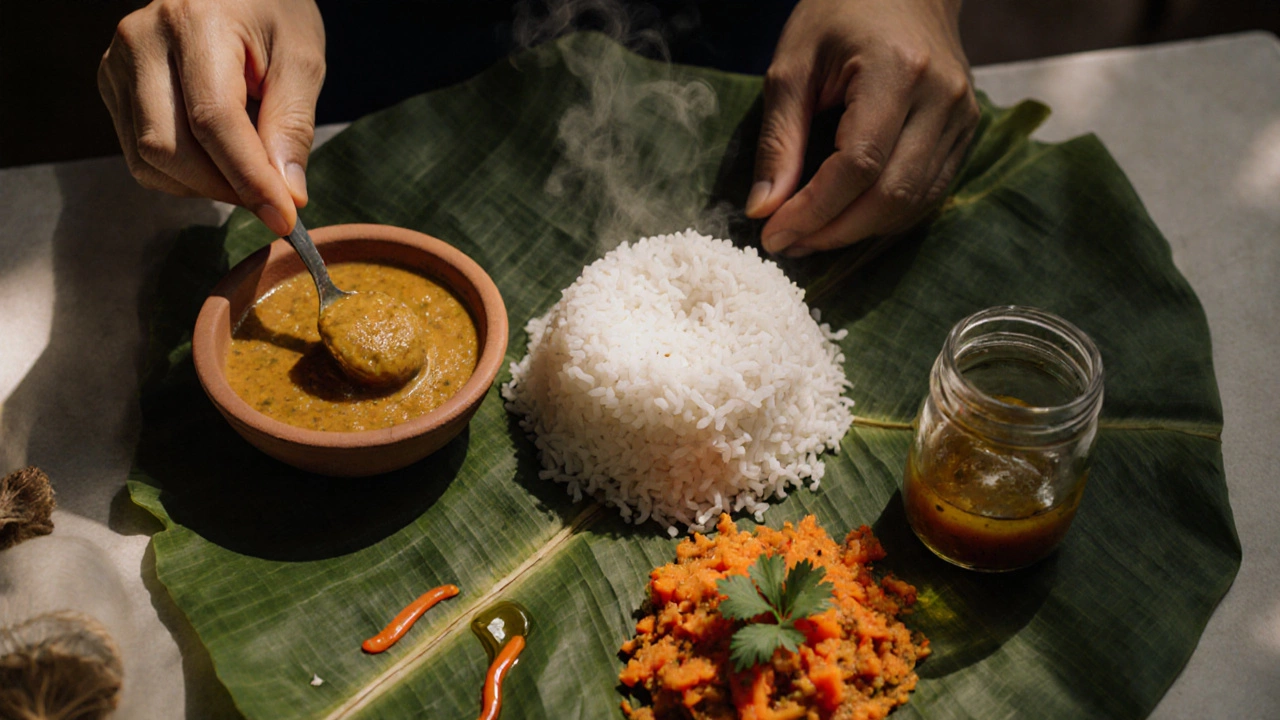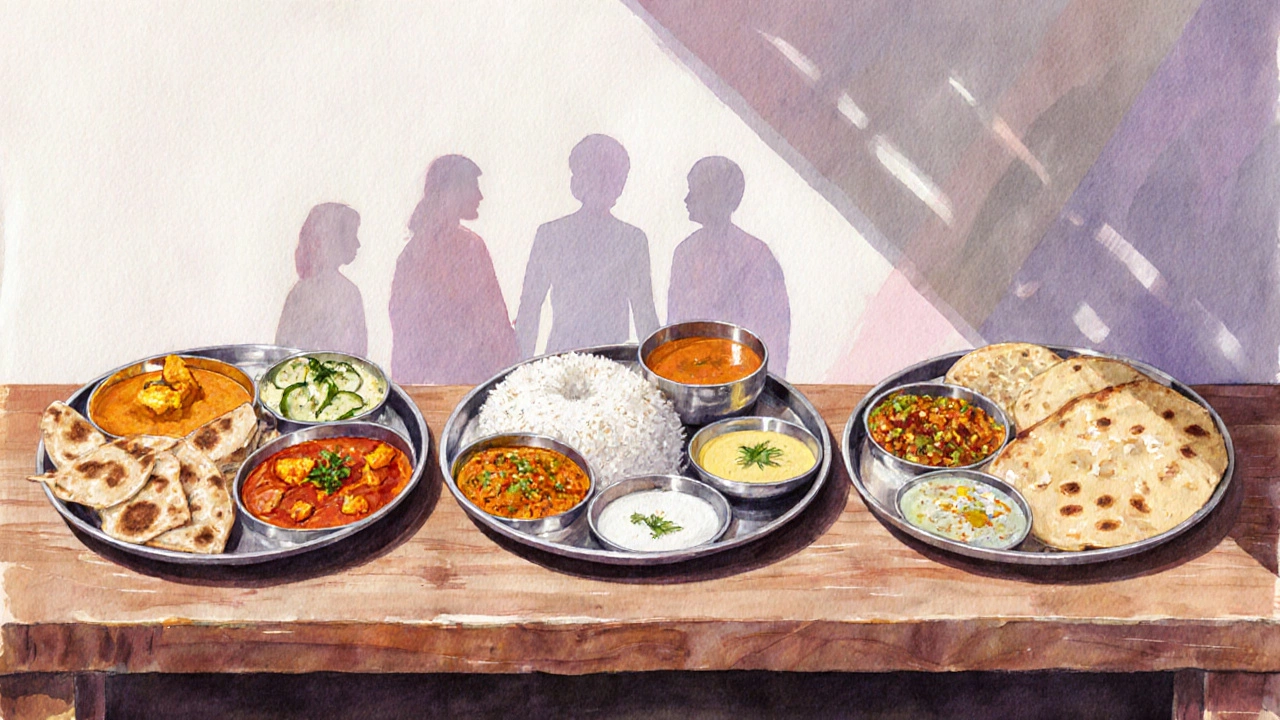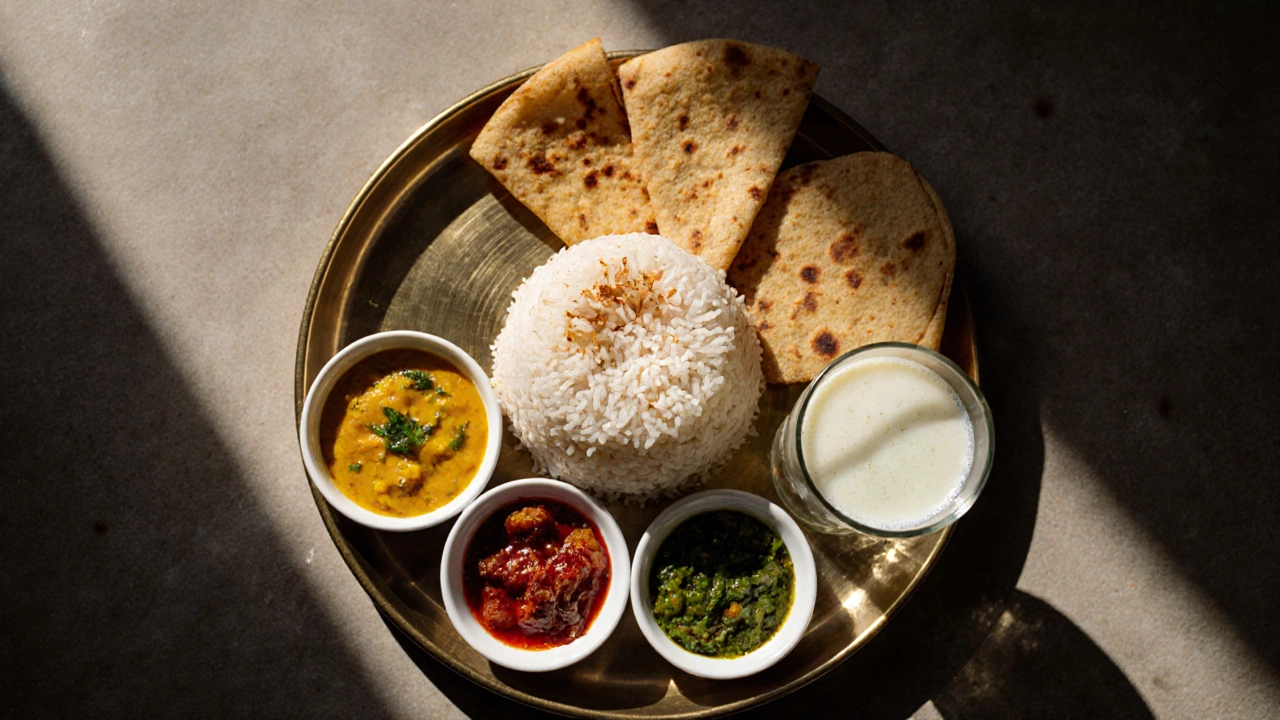Indian Thali Calorie Calculator
Select Your Components
How to Use
- Roti: 100 calories per piece
- Dal: 150 calories per 1/2 cup
- Rice: 110 calories per 1/2 cup
- Sabzi: 70 calories per 1/2 cup
- Chutney: 20 calories per tbsp
- Pickle: 5 calories per tsp
- Lassi: 120 calories per cup
Estimated Calories
Typical thali range: 600-800 calories
When you hear the phrase traditional Indian lunch, you probably imagine a colorful plate loaded with soups, breads, rice, veggies, and a splash of sweet or tangy sides. It’s not just about the food; it’s a whole experience that balances flavors, textures, and nutrition in a single sitting.
Quick Takeaways
- A traditional Indian lunch is usually served as a Thali, a round metal or leaf plate that holds multiple small dishes.
- Core components include Roti (flatbread), Dal (lentil curry), Rice, and a vegetable side called Sabzi.
- Tangy Pickles and fresh Chutney add zing, while a cool Lassi balances spice.
- Regional variations change the bread, rice type, and spice level but keep the same structure.
- Recreating a thali at home is easy: pick a few core dishes, keep portions small, and arrange them nicely on a plate.
What Makes a Traditional Indian Lunch?
At its heart, a lunch in India is about balance. The meal is built around four pillars: a staple (usually rice or wheat), a protein source (dal or meat), a vegetable side, and a condiment that awakens the palate. Historically, families ate together on the floor, sharing a communal plate. Today, the same idea lives on a metal or banana leaf Thali, which holds a dozen small bowls called katoris.
The thali lets you sample everything without feeling heavy. A bite of rice, a spoonful of dal, a spoon of vegetable, a dip in chutney-each flavor plays off the next. The food is generally mild enough to be enjoyed in the midday heat, yet seasoned enough to keep you satisfied until dinner.
Core Components of the Lunch Thali
Below are the staple items you’ll find on almost any traditional Indian lunch. Each one has a simple definition and a few variations.
Roti (Flatbread)
Roti is an unleavened wheat flatbread cooked on a hot griddle called a tava. It can be thin like a tortilla or slightly thicker, depending on the region. In the north, you’ll see tandoori roti baked in a clay oven, while in the south, chapati is the go‑to.Dal (Lentil Curry)
Dal refers to any cooked lentil dish, seasoned with turmeric, cumin, garlic, and sometimes tomatoes. Popular varieties include tadka dal (tempered with oil‑fried spices) and dal makhani (creamy black lentils).Rice
Rice is often the carb base in southern and eastern Indian lunches. You’ll see plain steamed rice, fragrant basmati rice, or a slightly fermented idli rice used for dishes like curd rice.Sabzi (Vegetable Side)
Sabzi means any cooked vegetable or mixed veg dish. It can be a dry stir‑fry, a gravy‑rich curry, or a simple tempered spinach. The spice level varies by household.Pickles (Achar)
Pickles are tangy, often spicy preserves made from mango, lemon, or mixed vegetables. They’re stored in oil and seasoned with mustard seeds, fenugreek, and chili powder.Chutney
Chutney is a fresh condiment-think coriander‑mint, coconut, or tomato-blended with green chilies, ginger, and a splash of lemon.Lassi (Yogurt Drink)
Lassi is a smooth yogurt‑based drink, either sweet (with sugar and fruit) or salty (with cumin and salt). It cools the palate and aids digestion.
How to Assemble a Thali: Step‑by‑Step
- Start with the staple: place a mound of rice at the center or a stack of roti on one side of the plate.
- Add a generous ladle of dal next to the rice. Drizzle a little ghee for richness if you like.
- Arrange the sabzi in a separate bowl-make sure the color contrasts with the dal.
- Spoon a small portion of pickle and a dollop of chutney on the edges.
- If you have a side of papad (thin crisp wafer) or a boiled egg, place it for extra crunch or protein.
- Fill a glass with chilled lassi or a simple glass of water.
- Finish with a sprinkling of fresh cilantro, a wedge of lemon, or a dash of chaat masala for zing.
The visual appeal is key: bright yellows, reds, and greens make the meal inviting. Even if you’re cooking for one, mimic the layout on a small plate to get the authentic feel.
Regional Twists on the Traditional Lunch
India’s size means each state has its own spin on the thali. Here are three common variations.
- North Indian: The plate centers around butter‑rich dal, ghee‑tossed roti, and a creamy paneer sabzi. You might also see a side of raita (yogurt mixed with cucumber).
- South Indian: Rice dominates, paired with a thin tomato‑based sambar (lentil stew) and a coconut‑based rasam. Side dishes include spicy poriyal (vegetable stir‑fry) and crispy appalam (papad).
- West Indian (Gujarati): A slightly sweet flavor profile with dal seasoned with jaggery, a flatbread called thepla, and a tangy khatti mithi kadhi (yogurt soup).
Even with these differences, the core idea-balanced carbs, protein, veg, and condiment-remains constant.
Tips for Recreating the Experience at Home
- Prep in batches: Cook dal and rice ahead of time. They keep well in the fridge for a day.
- Use small bowls: Anything between 3‑5 ounces works. It forces you to keep portions modest.
- Pick a theme: Choose a region and stick to its flavor profile. It makes shopping easier.
- Don’t overcrowd: The plate should have space for each item. Too many dishes feel chaotic.
- Balance spice: If you’re serving guests, keep the heat mild and let them add extra chili on the side.

Common Mistakes to Avoid
Even seasoned cooks slip up sometimes. Here’s what to watch out for:
- Too much dal: A ladle is enough; over‑pouring makes the thali soggy.
- Skipping the condiment: Pickles and chutney are what bring the flavors together. Without them, the meal feels flat.
- Ignoring texture: Include something crunchy-papad, fried beans, or toasted nuts-to add contrast.
- Serving cold rice: Warm rice is essential. Cold rice changes the feel of the dal and sabzi.
Bringing It All Together
Understanding a Traditional Indian Lunch is more than memorizing recipes. It’s about the rhythm of flavors, the visual harmony of a thali, and the communal vibe of sharing a meal. With a few staple dishes and a mindful layout, you can recreate this experience any day of the week.
Frequently Asked Questions
What time is lunch typically eaten in India?
Lunch is usually served between 12pm and 2pm. In hotter regions it can be a lighter meal, while in cooler areas a heartier thali is common.
Can a traditional Indian lunch be vegetarian?
Absolutely. Most thalis are vegetarian by default, featuring dal, sabzi, paneer, and yogurt‑based sides. Meat is added only in specific regional or festive versions.
How many calories are in a typical Indian lunch?
A balanced thali ranges from 600 to 800 calories, depending on the amount of ghee, oil, and bread. Using whole‑grain roti and limiting deep‑fried items can keep it lighter.
What are good substitutes for ghee if I’m avoiding dairy?
Use clarified coconut oil or a blend of olive oil with a pinch of turmeric for color. The flavor won’t be identical, but it still adds richness.
Is it okay to eat the same thali every day?
You can, as long as you rotate the vegetables and lentils to get a variety of nutrients. Adding a fruit or salad on the side helps keep things fresh.
